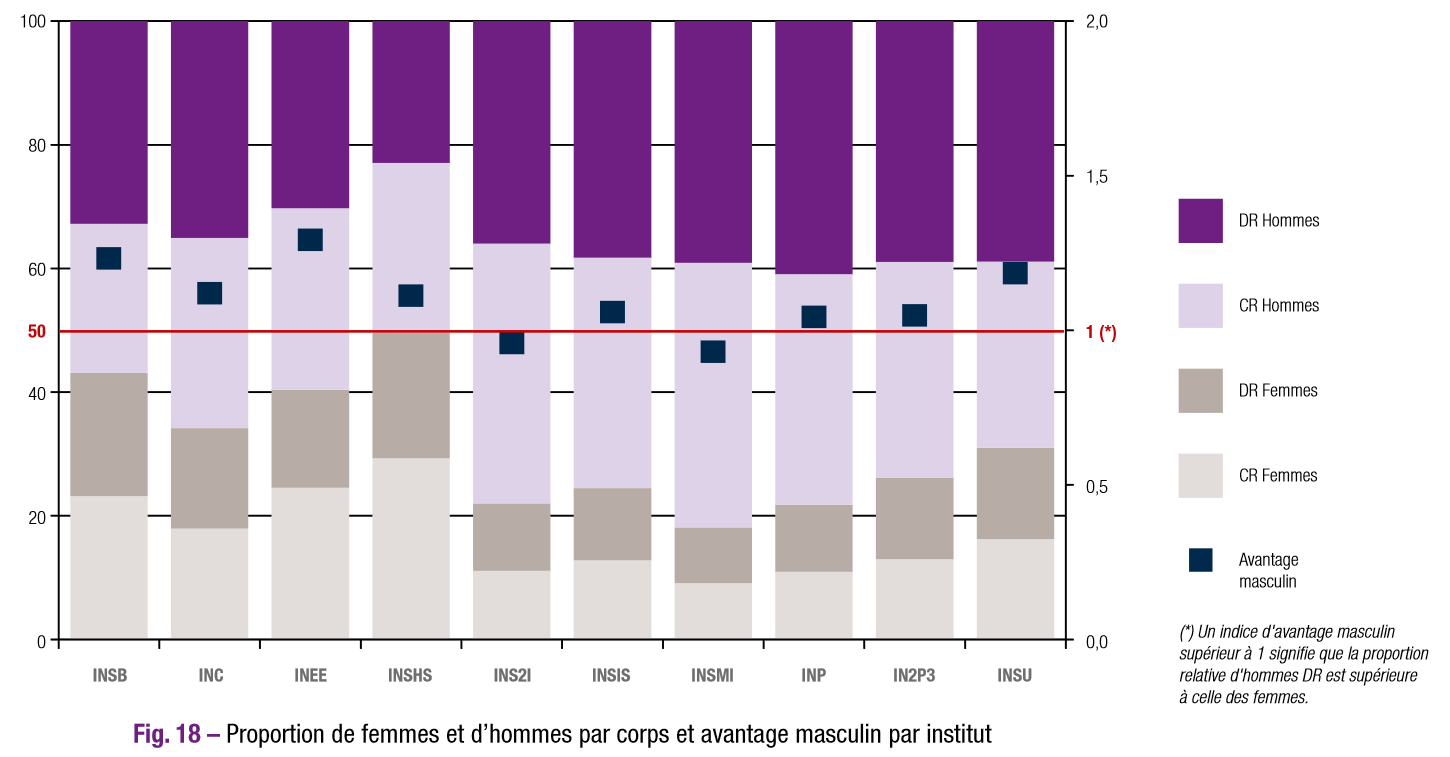Gender parity and professional equality between women and men
CNRS Physics is taking action to foster gender parity and equality on a daily basis in laboratories and to encourage young women to pursue careers in the field of physics. CNRS Physics has made this topic a priority by establishing a gender parity and equality team responsible for monitoring and implementing relevant measures. The work of our female researchers, lecturer-researchers, PhD students, engineers, and technicians is highlighted, along with best practices from CNRS Physics laboratories and the CNRS in this field. An annual training course has also been created to support women in their career paths within CNRS Physics laboratories.
CNRS Physics' Gender Parity and Equality Policy
The gender equality policy of CNRS Physics is part of the broader parity policy framework of CNRS. In this context, the institute has implemented a plan to improve gender parity and equality in its laboratories, with two main objectives:
- Increase the number of women entering physics laboratories
- Ensure that gender does not influence professional activities or career advancement
Preamble: Some Observations...
The CNRS Physics gender parity and equality policy was developed based on the following observations:
- Women are underrepresented in physics laboratories, and the number of young women choosing careers as physicists remains low.
- Although the number of women researchers in physics, mathematics, engineering, and computer science is relatively low, their chances of promotion are close to those of men, as shown by the Male Advantage Index. A male index of 1 means that the relative proportion of men promoted to research director is the same as that of women. However, in scientific fields with more female researchers—such as biology, humans and social sciences, and ecology—the Male Advantage Index is significantly above 1 (2023 data, see figure below).

- Female and male researchers participate less in training programs than engineers and technicians (IT staff, men and women combined), particularly in human resources training.
- While women often contribute to organizational support within labs, they less frequently hold leadership positions.
- Gender stereotypes (and other biases) remain prevalent in workplaces and labs. Awareness of these biases within decision-making groups (cf. evaluation committees) enables more effective application of parity and equality principles. Measuring gender stereotypes within a unit should help foster greater consideration to gender equality.
- An interruption in professional activity can create a disruption in the working lives of female engineers, technicians and researchers, which needs to be supported (financially and in terms of organization).
How Can Gender Parity and Equality Be Improved in CNRS Physics Laboratories?
The CNRS Physics policy to improve gender parity and equality in its laboratories is structured around three main pillars:
- Attractiveness of the discipline. CNRS Physics aims to increase communication and mediation initiatives to raise awareness among young girls about physics as a viable and engaging career path. Laboratories are strongly encouraged to incorporate these aspects into their public outreach initiatives (e.g., specific training for science outreach). CNRS Physics also actively promotes female physicists' careers through the Institute's communications.
- Laboratory Life. CNRS Physics seeks strong collaboration with laboratories to collectively improve parity and equality. To this end, the Institute proposes to relay, through a network of gender focal points per CNRS Physics unit that has yet to be developed, the actions already in place at CNRS and the tools available to raise awareness of these issues over the long term. (e.g., encouraging CNRS Physics labs to measure gender stereotypes, to follow the e-learning course on ‘gender inequality in research’ developed by the CNRS MPDF; set up specific parity and equality indicators for laboratories, etc.).
- Career Support. CNRS Physics is working to increase the proportion of women in leadership positions and encourages female candidates to apply for such roles. It also seeks to better support women’s careers, particularly after career interruptions such as maternity leave (sharing information on parenting support tools provided by HR departments in the Delegations and Head Office, offering financial assistance to help researchers return from maternity leave, prioritizing secondment requests from female lecturer-researchers returning from maternity leave, exploring funding and support measures to ensure optimal maternity leave conditions for support functions and by offering them specific training (see ANF – "Women in Physical Sciences, to enhance skills, boost self-confidence, and sharing experiences").
National Training Program (ANF): “Women in Physical Sciences”
In collaboration with the Île-de-France Shared Training Service (IFSeM), CNRS Physics offers a specific training program titled “Women in Physical Sciences: Enhancing Skills, Building Confidence, and Sharing Experiences.” This is aimed at researchers, engineers, technicians, and administrative staff, providing tools to help them thrive professionally within CNRS Physics laboratories.
Existing Gender Equality Initiatives at CNRS
- Mission for Women's Inclusion at CNRS (MPDF) – Established in 2001, reporting directly to the CEO. It coordinates a network of around twenty regional representatives and works closely with the CNRS Parity and Equality Committee. MPDF acts as a watchdog, providing guidance and evaluation on the integration of gender issues into CNRS’s overall policy.
- Parity and Equality Committee – Composed of representatives from institutes, HR, and MPDF, this committee makes recommendations to CNRS management, which gives them executive force when approved.
- Parity and Equality Coordinator Networks – Some CNRS delegations have created local networks focused on gender equality at their sites. Institutes such as CNRS Physics, CNRS Mathematics, and CNRS Computer Science have also developed their own internal networks. These networks offer a space to share experiences, legitimize parity-related actions, and visibly demonstrate the institute’s commitment to gender equality in laboratories.
CNRS Physics Gender Parity and Equality Unit
Co-leads : Bertrand Georgeot, Marie-Pierre Valignat
Members : Nina Bouchelaghem, Marta de Frutos, Séverine Martrenchard, Franck Menounga, Margaux Monvoisin, Lauren Puma
Contact us : inp-celluleparite@cnrs.fr
Best practices and recommendations
Bias-free, discrimination-free recruitment
- The Conseil Supérieur de l’Égalité Professionnelle provides practical tools, including a detailed guide to “equality at every step”.
- The European LIBRA project, in which the Institut Curie is a partner, has produced a practical guide to gender-neutral scientific recruitment.
- Self-training module: e-learning on unconscious bias and professional inequality (find out more on this page).
- Implicit associtation test
Find out more on MDPF's website
Parenting
A practical information sheet on the rights of young parents working as researchers can be found on the EFIGIES website.
Fighting harassment
Find out about actions to prevent harassment - Mission pour la Place Des Femmes au CNRS (Mission for the Place of Women at the CNRS).
Gender-neutral communication
On February 26, 2019, the CNRS signed the Agreement on Commitment to gender stereotype-free communication, from the High Council for Equality between Women and Men (Convention d’engagement pour une communication sans stéréotype de sexe, du Haut conseil pour l’égalité entre les femmes et les hommes). The CNRS and its bodies will formulate recommendations and proposals to ensure stereotype-free communication.
Read the Guide to stereotype-free communication.
Joint scientific events
- Recommendations of the CNRS Scientific Council “Towards parity in scientific events”.
- Parity charter for scientific conferences from the “Women & Physics” commission of the French Physical Society, supported by the CNRS and the “ Women & Science ” association.
Women in physics
Read the "Women in physics" news from CNRS Physique.
